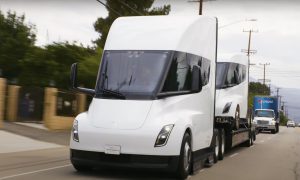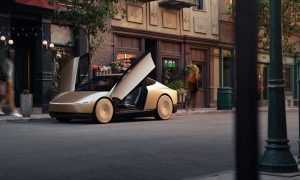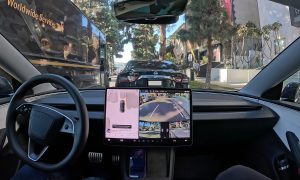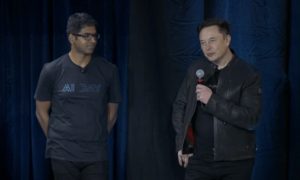News
Tesla Full Self-Driving could soon be allowed in Germany, gov approves legislation aimed at autonomous driving
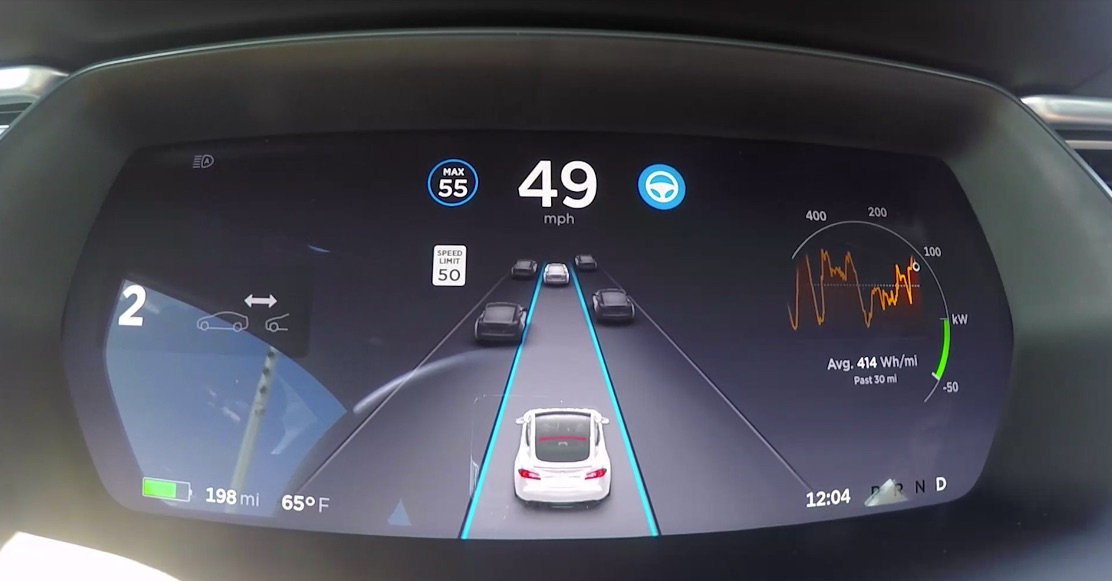
The national Parliament of the Federal Republic of Germany decided on Thursday to change an existing traffic law that had prohibited vehicles from being engaged in autonomous mode. Drawing on votes from both the Social Democratic Party (SPD) and the Christian Democratic Union (CSU), the Bundestag has agreed to allow fully autonomous driving vehicles to travel on Germany’s streets. The (translated) law reads, in part,
“During vehicle driving, the driver may turn away from traffic and vehicle control by means of highly automated or fully automated driving function… [but must] immediately [assume control] if he recognizes that the conditions for the intended use of the highly or fully automated driving functions no longer exist… even if he does not control the vehicle in the context of the intended use of this function.”
The law provides a balance between driver responsibility in the event of traffic incident and the ability of the the driver to release control of the vehicle to a control system, depending on situation and duration. The driver must retain the capacity to reassume control as well as to deactivate the control system. All vehicles with autonomous driving systems would have a “black box” data storage system, which would assist in determining fault in the event of an accident.
The new German law supersedes the 1968 “Vienna Convention on Road Traffic,” which specified that human drivers must have full control over their vehicle at any time. Of course, at that time of that law’s implementation, autonomous vehicles had not yet been introduced.
Tensions were high immediately preceding the vote, according to Germany’s golem.de newspaper, which described the level of autonomy to be permitted as “highly automated and fully automatic vehicles.” SPD deputy Kirsten Lühmann accusing the body of assigning drivers the roles of “experimental rabbits for new technology.” Stephan Kühn, the Green party deputy, also disagreed with the extent of the law. “It is not enough just to formulate in the justification of the legal text what the driver is allowed to do without worry while the computer is driving the car. This must be re-written into the law itself.”
The SPD defended the amendments as sound and timely.
German Federal Minister of Transport Alexander Dobrindt (CSU) had offered draft legislation for the new law in February, but it received violent criticism and underwent significant revision, particularly around data protection regulations. At the beginning of this week’s debate, he envisioned Germany as having “the most modern road traffic law in the world.” Dobrindt has rationalized the law as providing value added software innovation that could be homegrown in Germany and Europe. With the new systems, he said, will come increased traffic safety, fewer traffic jams, and reduced environmental pollution [emphasis added].
Germany is a forerunner for European autonomous driving, with some sections of public highways already designated as live testing zones. The Institute for the German Economy calculates that Germany has registered 58% of all global patents in autonomous driving since 2010.
The approved revision states that the owner of the car is still liable for actions taken while under autonomous mode, as prescribed by section 7 of the Road Traffic Act (Hazard Liability). Specific German autonomous driving regulations have not yet been established; those will come alongside international regulations and definitions and will likely change, too, as technological development in autonomous driving continues to progress. Like so many in the auto industry today, German engineers, scientists, and regulators are in a race to figure out the details of how autonomous cars will function so that they can be market ready by the early 2020’s.
Of course, Elon Musk, Tesla’s CEO, has stated that his company’s electric vehicles will have autonomous capability by the second half of 2017. The Society of Automotive Engineers has identified different levels of autonomy, ranging from 0 to Level 5, with Level 5 signifying that a vehicle can drive itself at all times under all conditions and need no input from a human. Level 4 autonomy refers to a vehicle that can be autonomous almost all the time, within determined parameters, as seems to be outlined by the Bundestag.
Interestingly, according to Musk’s statements, Teslas may soon be able to approach Level 4. That would make Tesla R&D far ahead of any German innovation currently underway.
With a bicameral parliament, Germany has two chambers: the Bundestag (lower house) and the Bundesrat (Federal Council or upper house). Both chambers can initiate legislation, and most bills must be approved by both chambers, as well as the executive branch, before becoming law. Now that the autonomous driving legislation has been approved by the Bundestag, it will go before the Federal Council. Coalition forces feel confident that this week’s modifications to Dobrindt’s original draft proposal are sufficient to pass through the Bundestrat.
Bitkom CEO Bernhard Rohleder was excited about the law, saying, “The Bundestag has cleared the way for the Automnation Deutschland to be the world leader in autonomous driving.” He acknowledged that changes will occur around liability rules or the use of data. “But we must not make the mistake of trying to settle everything down to the end in a long-term debate, then other countries will create facts and we will have the opportunity to use this technology.”
The first production vehicles equipped with autonomous driving features will be introduced to Germany sometime in 2017. “We can also be innovative in the legal framework and do not need to hide from the Silicon Valley ,” said Ulrich Lange (CSU), a CSU member, argued during the final moments of debate.
News
Tesla UK sales see 14% year-over-year rebound in June: SMMT data
The SMMT stated that Tesla sales grew 14% year-over-year to 7,719 units in June 2025.

Tesla’s sales in the United Kingdom rose in June, climbing 14% year-over-year to 7,719 units, as per data from the Society of Motor Manufacturers and Traders (SMMT). The spike in the company’s sales coincided with the first deliveries of the updated Model Y last month.
Model Y deliveries support Tesla’s UK recovery
Tesla’s June performance marked one of its strongest months in the UK so far this year, with new Model Y deliveries contributing significantly to the company’s momentum.
While the SMMT listed Tesla with 7,719 deliveries in June, independent data from New AutoMotive suggested that the electric vehicle maker registered 7,891 units during the month instead. However, year-to-date figures for Tesla remain 2% down compared to 2024, as per a report from Reuters.
While Tesla made a strong showing in June, rivals are also growing. Chinese automaker BYD saw UK sales rise nearly fourfold to 2,498 units, while Ford posted the highest EV growth among major automakers, with a more than fourfold increase in the first half of 2025.
Overall, the UK’s battery electric vehicle (BEV) demand surged 39% to to 47,354 units last month, helping push total new car sales in the UK to 191,316 units, up 6.7% from the same period in 2024.
EV adoption accelerates, but concerns linger
June marked the best month for UK car sales since 2019, though the SMMT cautioned that growth in the electric vehicle sector remains heavily dependent on discounting and support programs. Still, one in four new vehicle buyers in June chose a battery electric vehicle.
SMMT Chief Executive Mike Hawes noted that despite strong BEV demand, sales levels are still below regulatory targets. “Further growth in sales, and the sector will rely on increased and improved charging facilities to boost mainstream electric vehicle adoption,” Hawes stated.
Also taking effect this week was a new US-UK trade deal, which lowers tariffs on UK car exports to the United States from 27.5% to 10%. The agreement could benefit UK-based EV producers aiming to expand across the country.
News
Tesla Model 3 ranks as the safest new car in Europe for 2025, per Euro NCAP tests
Despite being on the market longer than many of its rivals, the Tesla Model 3 continues to set the bar for vehicle safety.

The Tesla Model 3 has been named the safest new car on sale in 2025, according to the latest results from the Euro NCAP. Among 20 newly tested vehicles, the Model 3 emerged at the top of the list, scoring an impressive 359 out of 400 possible points across all major safety categories.
Tesla Model 3’s safety systems
Despite being on the market longer than many of its rivals, the Tesla Model 3 continues to set the bar for vehicle safety. Under Euro NCAP’s stricter 2025 testing protocols, the electric sedan earned 90% for adult occupant protection, 93% for child occupant protection, 89% for pedestrian protection, and 87% for its Safety Assist systems.
The updated Model 3 received particular praise for its advanced driver assistance features, including Tesla’s autonomous emergency braking (AEB) system, which performed well across various test scenarios. Its Intelligent Speed Assistance and child presence detection system were cited as noteworthy features as well, as per a WhatCar report.
Other notable safety features include the Model 3’s pedestrian-friendly pop-up hood and robust crash protection for both front and side collisions. Euro NCAP also highlighted the Model 3’s ability to detect vulnerable road users during complex maneuvers, such as turning across oncoming traffic.
Euro NCAP’s Autopilot caution
While the Model 3’s safety scores were impressive across the board, Euro NCAP did raise concerns about driver expectations of Tesla’s Autopilot system. The organization warned that some owners may overestimate the system’s capabilities, potentially leading to misuse or inattention behind the wheel. Even so, the Model 3 remained the highest-scoring vehicle tested under Euro NCAP’s updated criteria this year.
The Euro NCAP’s concerns are also quite interesting because Tesla’s Full Self-Driving (FSD) Supervised, which is arguably the company’s most robust safety suite, is not allowed for public rollout in Europe yet. FSD Supervised would allow the Model 3 to navigate inner city streets with only minimal human supervision.
Other top scorers included the Volkswagen ID.7, Polestar 3, and Geely EX5, but none matched the Model 3’s total score or consistency across categories. A total of 14 out of 20 newly tested cars earned five stars, while several models, including the Kia EV3, MG ZS, and Renault 5, fell short of the top rating.
Elon Musk
Why Tesla’s Q3 could be one of its biggest quarters in history
Tesla could stand to benefit from the removal of the $7,500 EV tax credit at the end of Q3.

Tesla has gotten off to a slow start in 2025, as the first half of the year has not been one to remember from a delivery perspective.
However, Q3 could end up being one of the best the company has had in history, with the United States potentially being a major contributor to what might reverse a slow start to the year.
Earlier today, the United States’ House of Representatives officially passed President Trump’s “Big Beautiful Bill,” after it made its way through the Senate earlier this week. The bill will head to President Trump, as he looks to sign it before his July 4 deadline.
The Bill will effectively bring closure to the $7,500 EV tax credit, which will end on September 30, 2025. This means, over the next three months in the United States, those who are looking to buy an EV will have their last chance to take advantage of the credit. EVs will then be, for most people, $7,500 more expensive, in essence.
The tax credit is available to any single filer who makes under $150,000 per year, $225,000 a year to a head of household, and $300,000 to couples filing jointly.
Ending the tax credit was expected with the Trump administration, as his policies have leaned significantly toward reliance on fossil fuels, ending what he calls an “EV mandate.” He has used this phrase several times in disagreements with Tesla CEO Elon Musk.
Nevertheless, those who have been on the fence about buying a Tesla, or any EV, for that matter, will have some decisions to make in the next three months. While all companies will stand to benefit from this time crunch, Tesla could be the true winner because of its sheer volume.
If things are done correctly, meaning if Tesla can also offer incentives like 0% APR, special pricing on leasing or financing, or other advantages (like free Red, White, and Blue for a short period of time in celebration of Independence Day), it could see some real volume in sales this quarter.
You can now buy a Tesla in Red, White, and Blue for free until July 14 https://t.co/iAwhaRFOH0
— TESLARATI (@Teslarati) July 3, 2025
Tesla is just a shade under 721,000 deliveries for the year, so it’s on pace for roughly 1.4 million for 2025. This would be a decrease from the 1.8 million cars it delivered in each of the last two years. Traditionally, the second half of the year has produced Tesla’s strongest quarters. Its top three quarters in terms of deliveries are Q4 2024 with 495,570 vehicles, Q4 2023 with 484,507 vehicles, and Q3 2024 with 462,890 vehicles.
-

 Elon Musk4 days ago
Elon Musk4 days agoTesla investors will be shocked by Jim Cramer’s latest assessment
-

 News1 week ago
News1 week agoTesla Robotaxi’s biggest challenge seems to be this one thing
-

 Elon Musk2 weeks ago
Elon Musk2 weeks agoFirst Look at Tesla’s Robotaxi App: features, design, and more
-

 News2 weeks ago
News2 weeks agoSpaceX and Elon Musk share insights on Starship Ship 36’s RUD
-

 News2 weeks ago
News2 weeks agoWatch Tesla’s first driverless public Robotaxi rides in Texas
-

 News1 week ago
News1 week agoWatch the first true Tesla Robotaxi intervention by safety monitor
-

 News2 weeks ago
News2 weeks agoTesla has started rolling out initial round of Robotaxi invites
-

 Elon Musk2 weeks ago
Elon Musk2 weeks agoTesla to launch in India in July with vehicles already arriving: report


